Irish Spirits
The Irish Pub
 In Ireland there is no shortage of good pubs. They are famous the world over for their rowdy and vibrant atmosphere, good music,
In Ireland there is no shortage of good pubs. They are famous the world over for their rowdy and vibrant atmosphere, good music,
good drink and good food. You will find pubs to be very community orientated and a great way to meet the locals, learn some history and really experience the culture. You may even find an Irish pub that's actually the front living room of someone's house, with one or two pumps, a couple of bottles of spirits and maybe some chairs, although these kind of pubs are usually found in remote villages.
The custom of imbibing alcohol on St. Patrick's Day comes from an old Irish legend. Legends like this abound throughout the Irish communities and provinces and I cannot attest as to the veracity of this next tale. Nonetheless, as the story goes, St. Patrick was served a measure of whiskey that was considerably less than full. St. Patrick took this as an opportunity to teach a lesson of generosity to the innkeeper. He told the innkeeper that in his cellar resided a monstrous devil who fed on the dishonesty of the innkeeper. In order to banish the devil, the man must change his ways.
innkeeper. He told the innkeeper that in his cellar resided a monstrous devil who fed on the dishonesty of the innkeeper. In order to banish the devil, the man must change his ways.
When St. Patrick returned to the hostelry some time later, he found the owner generously filling the patrons' glasses to overflowing. He returned to the cellar with the innkeeper and found the devil emaciated from the landlord's generosity, and promptly banished the demon, proclaiming
thereafter everyone should have a drop of the "hard stuff" on his feast day. Known as "drowning the shamrock" because it is customary to float a leaf of the plant in the whiskey before downing the shot, this custom is known as Pota Phadraig or Patrick's Pot.

Brewed from apples, this alcoholic drink has become very popular in recent years and is drunk by the pint like beer. Its higher alcohol content makes it more "effective" than most beer, while being served ice-cold as a refreshing drink. Drinkers beware! The most popular Irish cider is Bulmer's, named (for trademark reasons) Magner's in Northern Ireland.
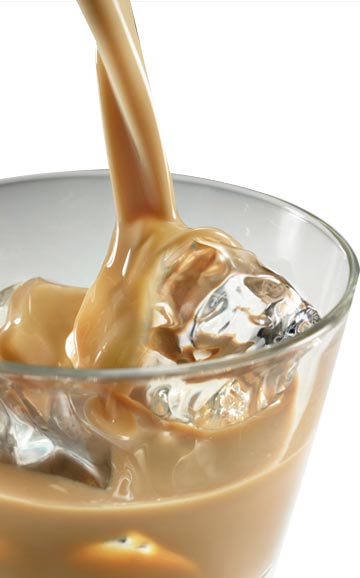
Apart from the well-known "Bailey's Irish Cream," several similar liquors are available and targeted mostly at the female market. While the ingredients are basically the same, their proportions vary and so does the taste of these liquors. Normally drunk moderately cool, they are also available on ice or as a shot in black coffee.
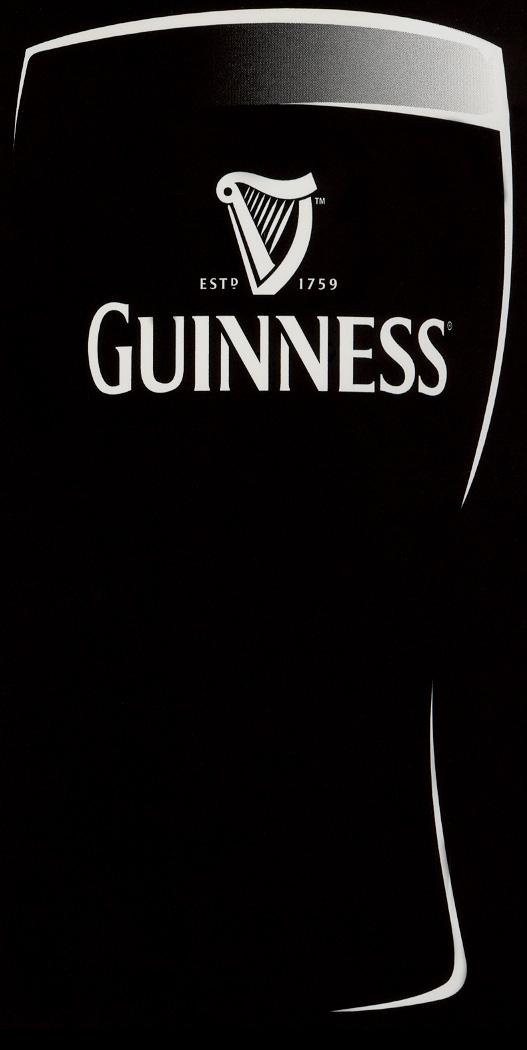
In 1759, Arthur Guinness leased the
St. James's Gate Brewery and soon after began brewing the popular London porter. He and his family have never looked back. Hence, the porter or stout is synonymous with the family namenow. No longer given away free to new mothers as a lukewarm restorative in Dublin hospitals but available on tap everywhere, Guinness is the quintessential Irish beer. And an acquired taste.
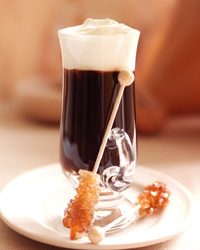
This beverage was invented shortly after the Second World War by an enterprising Irish barman as
a means to revive the
flagging spirits of
transatlantic air passengers. It combines a good shot of Irish whiskey, steaming hot and strong black coffee, topped with thick double cream poured over the back of a spoon. An excellent restorative after a few miles of vigorous walking on a windswept beach.
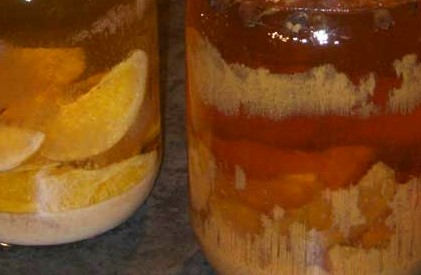
Gone out of fashion slightly since the Viking raids, mead has made a comeback in the last few years as an alternative drink somewhere between beers and liquors. Combining the sweetness of honey with the bite of alcohol, meads are popular after-dinner drinks. The variety can be bewildering, some meads are similar to wine or beer, others are medium-strength liquors.

The Irish love their beers - every pub will serve a wide variety on draft or in bottles. Popular Irish beers are Murphy's Stout, Kilkenny and Smithwick's. English and Scottish "lagers" are preferred by the less discerning drinker in a hurry.
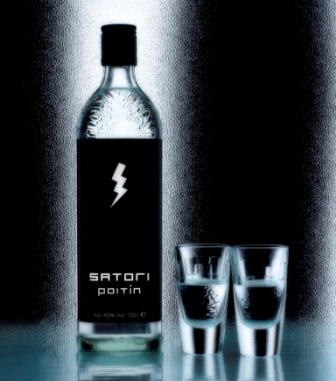
This is the most Irish of drinks and could be described as a neat spirit distilled from whatever was at hand. More specifically the word refers to a strong spirit (on par with German schnapps) made from potatoes. Produced for centuries in moonshine stills up and down the country by tax-conscious enthusiasts. Today poitín (or poteen) can be bought legally and with fewer associated health hazards in most off-licenses.
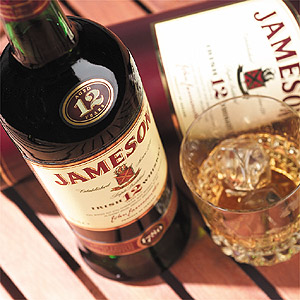 There are several types of whiskey common to Ireland: Single Malt, Single Grain, Pure Pot Still and Blended. The Irish in turn learned about it, according to the Irish at least, from missionary monks who arrived in Ireland in the seventh century. Barley-based whiskey (the word derives from uisce beatha, the Gaelic interpretation of aqua vitae) first appears in the historical record in the mid-1500s when the Tudor kings began to consolidate English control in Ireland. Queen Elizabeth I was said to be fond of it and had casks shipped to London on a regular basis.
There are several types of whiskey common to Ireland: Single Malt, Single Grain, Pure Pot Still and Blended. The Irish in turn learned about it, according to the Irish at least, from missionary monks who arrived in Ireland in the seventh century. Barley-based whiskey (the word derives from uisce beatha, the Gaelic interpretation of aqua vitae) first appears in the historical record in the mid-1500s when the Tudor kings began to consolidate English control in Ireland. Queen Elizabeth I was said to be fond of it and had casks shipped to London on a regular basis.
Irish whiskeys, both blended and malt, are usually triple distilled through both column and pot stills, although there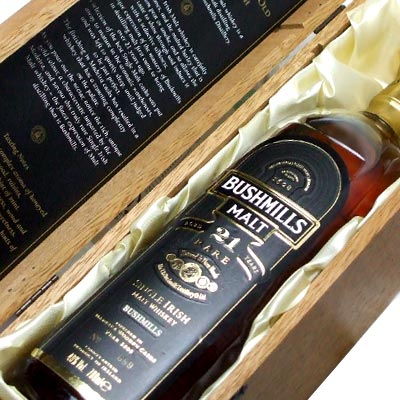 are a few exclusively pot-distilled brands.
are a few exclusively pot-distilled brands.
Irish Pure Pot Still Whiskey is generally labeled as such. Otherwise, Irish whiskeys are a mix of pot and column-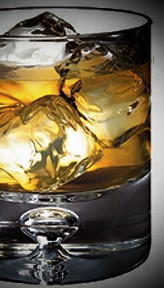 distilled whiskeys. Irish Malt Whiskey is likewise so designated. Standard Irish Whiskey is a blend of malt and grain whiskies.
distilled whiskeys. Irish Malt Whiskey is likewise so designated. Standard Irish Whiskey is a blend of malt and grain whiskies.
Popular both in neat and mixed forms. Several well-known brands are available, the most popular being Old Bushmills, Tullamore Dew, Power's, Paddy's and Jameson's. Whiskeys are available in blended form or as single grain and single malt pure produce. Tourists should take note that high taxes make Irish whiskey more expensive in Ireland than in a lot of other countries.
Irish Wines
 That's right you read that correctly. The European Commission has now officially listed Ireland as a wine producing country. David Llewellyn’s Lusca Vineyards, on the north Dublin coast, is growing cabernet sauvignon, merlot and several other grape varietals along with the rondo grape, a hybrid cross of Zarya Severa and St. Laurent. His vinyard originally planted German vines, bred especially for cooler climates,
That's right you read that correctly. The European Commission has now officially listed Ireland as a wine producing country. David Llewellyn’s Lusca Vineyards, on the north Dublin coast, is growing cabernet sauvignon, merlot and several other grape varietals along with the rondo grape, a hybrid cross of Zarya Severa and St. Laurent. His vinyard originally planted German vines, bred especially for cooler climates,
including Madeleine Angevine and some Pinot Noir. Llewellyn thinks that while the denizens of Burgundy and Bordeaux might not be trembling, there is real potential for a serious winery in Ireland. The Lusca wine range includes a red made from a blend of David’s Cabernet Sauvignon and Merlot grapes, and two crisp, dry varietal wines from Sauvignon Blanc or Chardonnay. The whites are refreshing and youthful, while the red can be drunk at around two years, but has the capacity for aging on to produce a much more sophisticated taste.
***
Well there you have it. I hope that you have enjoyed our trip through Ireland and its spirits. Don't forget when enjoying yourself this St Patrick's Day, be careful and drink responsibly.
"What's that you're on about...? Oh, okay.... Tis' a yarn you'll be wanting to hear now, eh ? Well then I'll be leavin ya with this:"
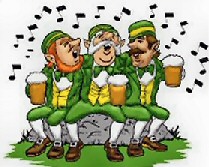 A Texan walks into a pub in Galway, Ireland and raises his voice to the crowd of drinkers. He shouts, 'I hear y'all Irish can really drink. I'll give $500 American dollars to anybody in here who can drink 10 pints of Guinness back to back.'
A Texan walks into a pub in Galway, Ireland and raises his voice to the crowd of drinkers. He shouts, 'I hear y'all Irish can really drink. I'll give $500 American dollars to anybody in here who can drink 10 pints of Guinness back to back.'
The room is quiet and no one takes of the Texan's offer.
From a table in the back, Paddy Murphy gets up and leaves the bar. Thirty minutes later, he re-enters the pub and taps the Texan on the shoulder. 'Is your bet still good?' asks Paddy.
The Texan answers, 'Yes,' and he orders the barman to line up 10 pints of Guinness.
Immediately, Paddy downs all 10 pints of beer, drinking them all back to back. The other pub patrons cheer and the Texan sits down in amazement. As he hands the Irishman the $500, he asks, 'If y'all don't mind me askin', where'd you git to for that 30 minutes you were gone?'
Paddy replied, 'Well now laddie......I wanted to take your bet when you first asked..........but just to be sure..............I went to the pub down the street to make sure I could do it before I said yes.'


